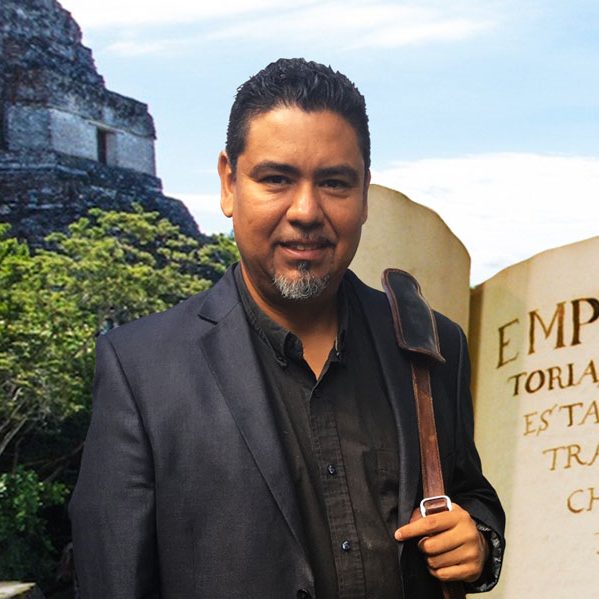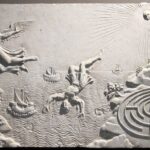The Ancient Greek figure Daedalus comes to us as a mythic image of the artist in its expansive universal dimension. The Artist is a highly complex archetype with many facets and functions. It cannot be properly studied in isolation, nor in the icy glare of pure of abstraction. As a living myth in its time, the myth of Daedalus and Icarus is embedded in a broader cultural matrix that interweaves myth and history into the collective fabric of civilization.
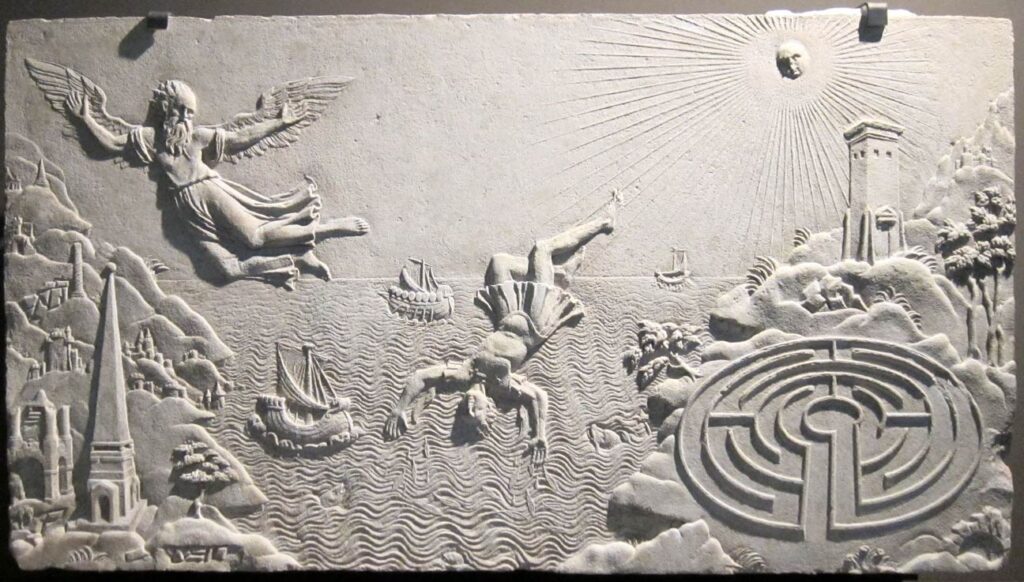
As Robert Graves writes, for example, all the various protagonists of the Daedalus myth can be seen as specific reflections or “attributes” of the same archetypal figure of universal human creativity:
Daedalus (‘bright’ or ‘cunningly wrought’), Talos (‘sufferer’), and Hephaestus (‘he who shines by day’), are shown by the similarity of attributes to be merely different titles of the same mythical character. Icarus (from io-carios, ‘dedicated to the Moon-goddess Car’) may yet be another of his titles.
The Greek Myths Vol 1. 293-294
Graves notes the secret identity-in-difference that is shared by all the figures associated with Daedelus—an archetypal network of partial identifications—whose divine ‘center’ is Hephaestus, the ‘hobbled’ God of artistic productivity and Vulcanic creation.
Let us dive back into the thick of the story with Robert Graves’ Greek Myths, in which the tragic fate of Icarus can be better understood in a broader context of the fate of King Minos.
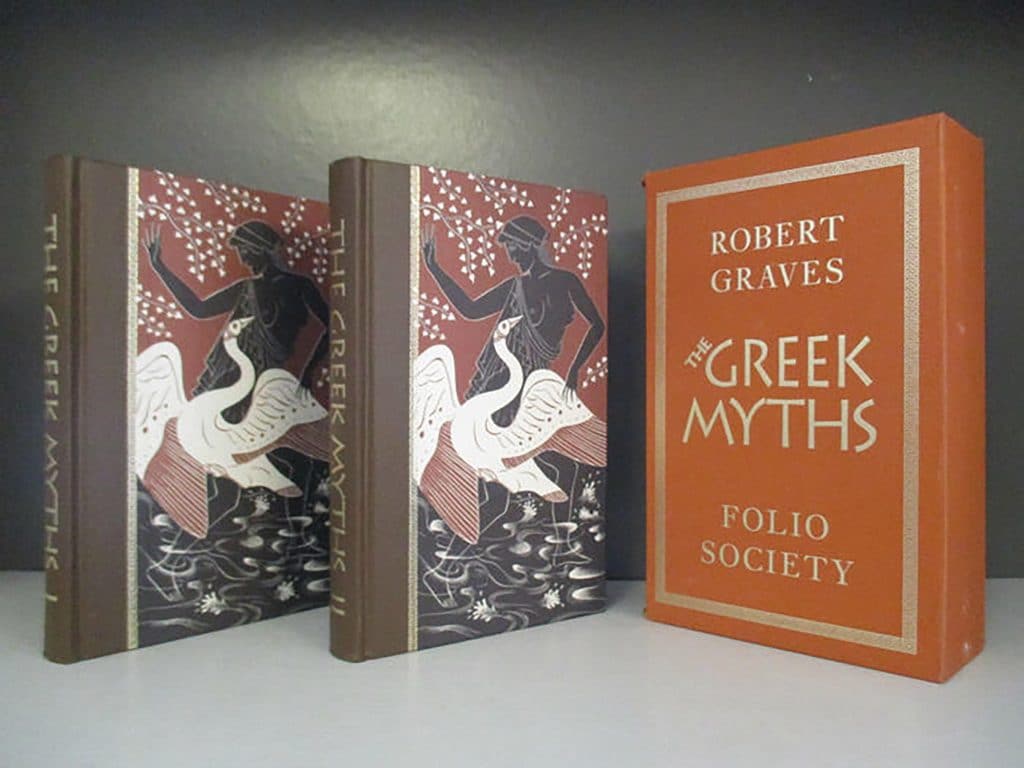
DAEDALUS AND TALOS
As told by Robert Graves in The Greek Myths (p. 290-296)
a. The parentage of Daedalus is disputed. His mother is named Alcippe by some; by others, Merope; by still others, Iphinoë; and all give him a different father, though it is generally agreed that he belonged to the royal house of Athens, which claimed descent from Erechtheus. He was a wonderful smith, having been instructed in his art by Athene herself.
b. One of his apprentices, Talos the son of his sister Polycaste, or Perdix, had already surpassed him in craftsmanship while only twelve years old. Talos happened one day to pick up the jawbone of a serpent or, some say, of a fish’s spine; and, finding that he could use it to cut a stick in half, copied it in iron and thereby invented the saw. This, and other inventions of his – such as the potter’s wheel, and the compass for marking out circles – secured him a great reputation at Athens, and Daedalus, who claimed himself to have forged the first saw, soon grew unbearably jealous. Leading Talos up to the roof of Athene’s temple on the Acropolis, he pointed out certain distant sights, and suddenly toppled him over the edge. Yet, for all his jealousy, he would have done Talos no harm had he not suspected him of incestuous relations with his mother Polycaste. Daedalus then hurried down to the foot of the Acropolis, and thrust Talos’s corpse into a bag, proposing to bury it secretly. When challenged by passers—by, he explained that he had piously taken up a dead serpent, as the law required – which was not altogether untrue, Talos being an Erechtheid – but there were bloodstains on the bag, and his crime did not escape detection, whereupon the Areiopagus banished him for murder. According to another account he fled before the trial could take place.
c. Now, the soul of Talos – whom some call Calus, Circinus, or Tantalus – flew off in the form of a partridge, but his body was buried where it had fallen. Polycaste hanged herself when she heard of his death, and the Athenians built a sanctuary in her honour beside the Acropolis.

d. Daedalus took refuge in one of the Attic demes, whose people are named Daedalids after him; and then in Cretan Cnossus, where King Minos delighted to welcome so skilled a craftsman. He lived there for some time, at peace and in high favour, until Minos, learning that he had helped Pasiphaë to couple with Poseidon’s white bull, locked him up for a while in the Labyrinth, together with his son Icarus, whose mother, Naucrate, was one of Minos’s slaves; but Pasiphaë freed them both.
e. It was not easy, however, to escape from Crete, since Minos kept all his ships under military guard, and now offered a large reward for his apprehension. But Daedalus made a pair of wings for himself, and another for Icarus, the quill feathers of which were threaded together, but the smaller ones held in place by wax. Having tied on Icarus’s pair for him, he said with tears in his eyes: ‘My son, be warned! Neither soar too high, lest the sun melt the wax; nor swoop too low, lest the feathers be wetted by the sea.’ Then he slipped his arms into his own pair of wings and they flew off. ‘Follow me closely,’ he cried, ‘do not set your own course!’
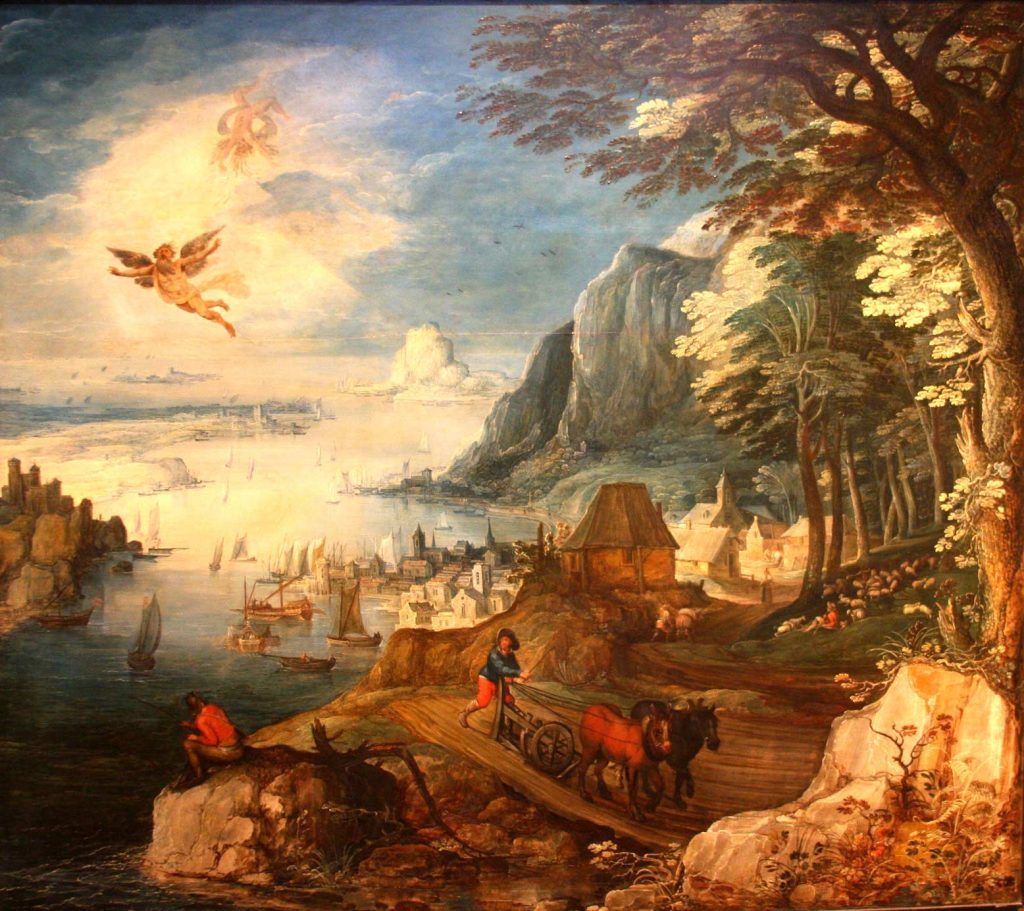
f. They had left Naxos, Delos, and Paros behind them on the left hand, and were leaving Lebynthos and Calymne behind on the right, when Icarus disobeyed his father’s instructions and began soaring towards the sun, rejoiced by the lift of his great sweeping wings. Presently, when Daedalus looked over his shoulder, he could no longer see Icarus; but scattered feathers floated on the waves below. The heat of the sun had melted the wax, and Icarus had fallen into the sea and drowned. Daedalus circled around, until the corpse rose to the surface, and then carried it to the near-by island now called Icaria, where he buried it. A partridge sat perched on a holm-oak and watched him, chattering for delight – the soul of his sister Polycaste, at last avenged. This island has now given its name to the surrounding sea.
g. But some, disbelieving the story, say that Daedalus fled from Crete in a boat provided by Pasiphaë; and that, on their way to Sicily, they were about to disembark at a small island, when Icarus fell into the sea and drowned. They add that it was Heracles who buried Icarus; in gratitude for which, Daedalus made so lifelike a statue of him at Pisa that Heracles mistook it for a rival and felled it with a stone. Others say that Daedalus invented sails, not wings, as a means of outstripping Minos’s galleys; and that Icarus, steering carelessly, was drowned when their boat capsized.


h. Daedalus flew westward until, alighting at Cumae near Naples, he dedicated his wings to Apollo there, and built him a golden—roofed temple. Afterwards, he visited Camicus in Sicily, where he was hospitably received by King Cocalus, and lived among the Sicilians, enjoying great fame and erecting many fine buildings.
i. Meanwhile, Minos had raised a considerable fleet, and set out in search of Daedalus. He brought with him a Triton shell, and wherever he went promised to reward anyone who could pass a linen thread thorough it: a problem which, he knew, Daedalus alone would be able to solve. Arrived at Camicus, he offered the shell to Cocalus, who undertook to have it threaded; and, sure enough, Daedalus found out how to do this. Fastening a gossamer thread to an ant, he bored a hole at the point of the shell and lured the ant up the spirals by smearing honey on the edges of the hole. Then he tied the linen thread to the other end of the gossamer and drew that through as well. Cocalus returned the threaded shell, claiming the reward, and Minos, assured that he had at last found Daedalus’s hiding—place, demanded his surrender. But Cocalus’s daughters were loth to lose Daedalus, who made them such beautiful toys, and with his help they concocted a plot. Daedalus led a pipe through the roof of the bathroom, down which they poured boiling water or, some say, pitch upon Minos, while he luxuriated in a warm bath. Cocalus, who may well have been implicated in the plot, returned the corpse to the Cretans, saying that Minos had stumbled over a rug and fallen into a cauldron of boiling water.
j. Minos’s followers buried him with great pomp, and Zeus made him a judge of the dead in Tartarus, with his brother Rhadamanthys and his enemy Aeacus as colleagues. Since Minos’s tomb occupied the centre of Aphrodite’s temple at Camicus, he was honoured there for many generations by great crowds of Sicilians who came to worship Aphrodite. In the end, his bones were returned to Crete by Theron, the tyrant of Acragas.
k. After Minos’s death the Cretans fell into complete disorder, because their main fleet was burned by the Sicilians. Of the crews who were forced to remain overseas, some built the city of Minoa, close to the beach where they had landed; others, the city of Hyria in Messapia; still others, marching into the centre of Sicily, fortified a hill which became the city of Enguos, so called from a spring which flows close by. There they built a temple of the Mothers, whom they continued to honour greatly, as in their native Crete.
l. But Daedalus left Sicily to join Iolaus, the nephew and charioteer of Tirynthian Heracles, who led a body of Athenians and Thespians to Sardinia. Many of his works survive to this day in Sardinia; they are called Daedaleia [or Daidala].
m. Now, Talos was also the name of Minos’s bull-headed servant, given him by Zeus to guard Crete. Some say that he was a survivor of the brazen race who sprang from the ash-trees; others, that he was forged by Hephaestus in Sardinia, and that he had only one vein, which ran from his neck down to his ankles, where it was stoppered by a bronze pin. It was his task to run thrice daily around the island of Crete and throw rocks at any foreign ship; and also to go thrice a year at a more leisurely pace, through the villages of Crete, announcing Minos’s laws inscribed on brazen tablets. When the Sardinians tried to invade the island, Talos made himself red-hot in a fire and destroyed them in his burning embrace, grinning fiercely; hence the expression ‘Sardonic grin’. In the end, Medea killed Talos by pulling out the vein and letting his life-blood escape; though some say that Poeas the transfixed him with a poisoned arrow.

NOTES by Robert Graves
1. Hephaestus is sometimes described as Hera’s son by Talos, and Talos as Daedalus’s young nephew; but Daedalus was a junior member of House of Erechtheus, which was founded long after the birth of Hephaestus. Such chronological discrepancies are the rule in mythology. Daedalus {‘bright’ or ‘cunningly wrought’), Talos (‘sufferer’), and Hephaestus (‘he who shines by day’), are shown by the similarity of attributes to be merely different titles of the same mythical character. Icarus (from io-carios, ‘dedicated to the Moon-goddess Car’) may yet be another of his titles. For Hephaestus the smith-god married to Aphrodite, to whom the partridge was sacred; the sister of Daedalus the smith is called Perdix (‘partridge’); the soul of Talos the smith flies off as a partridge; a partridge appeared at the burial of Daedalus’s son Icarus. Besides, Hephaestus was flung from Olympus; Talos was flung from the Acropolis. Hephaestus hobbled when he walked: one of Talos’s names was Tantalus (‘hobbling, or lurching’); a cock-partridge hobbles in his love-dance, holding one heel ready to strike at rivals. Moreover, the Latin god Vulcan hobbled. His cult had been introduced from Crete, where he was called Velchanus and had a cock for his emblem, because the cock crows at dawn and was therefore appropriate to a Sun-hero. But the cock did not reach Crete until the sixth century BC and is likely to have displaced the partridge as Velchanus’s bird.
2. It seems that in the spring an erotic partridge dance was performed in honour of the Moon-goddess, and that the male dancers hobbled and wore wings. In Palestine this ceremony, called the Pesach (‘the hobbling’) was, according to Jerome, still performed at Beth-Hoglah (‘the Shrine the Hobbler’), where the devotees danced in a spiral. Beth-Hoglah is identified with ‘the threshing-floor of Atad’, on which mourning was made for the lame King Jacob, whose name may mean Jah Aceb (‘the heel-god’). Jeremiah warns the Jews not to take part in those orgiastic Canaanite rites, quoting: ‘The partridge gathereth young that she have not brought forth.’ Anaphe, an island situated to the north of Crete, with which Minos made a treaty, was famous in antiquity as a resting-place for migrant partridges.
3. The myth of Daedalus and Talos, like its variant, the myth Daedalus and Icarus, seems to combine the ritual of burning the solar king’s surrogate, who had put on eagle’s wings, in the spring bonfire—when the Palestinian New Year began—with the rituals flinging the partridge-winged pharmacos, a similar surrogate, over a rock into the sea, and of pricking the king in the heel with a poisoned arrow. But the fishermen’s and peasants’ admiration of flying Daedalus is probably borrowed from an icon of the winged Perseus or Marduk.

4. In one sense the labyrinth from which Daedalus and Icarus escaped was the mosaic floor with the maze pattern, which they had to follow in the ritual partridge dance; but Daedalus’s escape to Sicily, Cumae, and Sardinia refers perhaps to the flight of the native bronze workers from Crete as the result of successive Hellenic invasions. A ruse of the Triton shell, and Minos’s burial in a shrine of Aphrodite to whom this shell was sacred, suggest that Minos was also, in context, regarded as Hephaestus, the Sea-goddess’s lover. His death in bath is an incident that has apparently become detached from the myth of Nisus and Scylla; Nisus’s Celtic counterpart, Llew Llaw was killed in a bath by a trick; and so was another sacred King, Agamemnon of Mycenae.
.5. The name Naucrate (‘sea-power’) records the historical consequences of Minos’s defeat in Sicily—the passing of sea-power from ruling Cretan into Greek bands. That she was one of Minos’s slaves suggests a palace revolution of Hellenic mercenaries at Cnossus.
6. If Polycaste, the other name of Talos’s mother Perdix, means polycassitere, ‘much tin’, it belongs to the myth of the bronze man, Talos’s namesake. Cretan supremacy depended largely on plentiful supplies of tin, to mix with Cyprian copper; according to Professor Christopher Hawkes, the nearest source was the island of Mallorca.
7. Talos is said by Hesychius to be a name for the Sun; originally, therefore, Talos will have coursed only once a day around Crete. Perhaps, however, the harbours of Crete were guarded against pirates by three corps of watches which sent out patrols. And since Talos the Sun was also called Taurus (‘the bull’), his thrice-yearly visit to the villages was probably a royal progress of the Sun-king, wearing his ritual bull-mask—the Cretan year being divided into three seasons. Talos’s red-hot embrace may record the human burnt sacrifices offered to Moloch, alias Melkarth, who was worshipped in Corinth as Melicertes, and probably also known in Crete. Since this Talos came from Sardinia, where Daedalus was said to have fled when pursued by Minos, and was at the same time Zeus’s gift to Minos, the mythographers have simplified the story by giving Hephaestus, rather than Daedalus, credit for its construction; Hephaestus and Daedalus being the same character. The sardonicus risus, or rictus, stiffening of the facial muscles, symptomatic of lock-jaw, was perhaps so called because the stag-man of early Sardinian bronzes wears the same gaping grin.
8. Talos’s single vein belongs to the mystery of early bronze casting by the cire-perdue method. First, the smith made a beeswax image which he covered with a layer of clay, and laid in an oven. As soon as the clay had been well baked he pierced the spot between heel and ankle, so that the wax ran out and deft a mould, into which molten bronze could be poured. When he had filled this, and the metal inside had cooled, he broke the clay, leaving a bronze image of the same shape as the original wax one. The Cretans brought the cire-perdue method to Sardinia, together with Daedalus cult. Since Daedalus learned his craft from Athene, who was known as Medea at Corinth, the story of Talos’s death may have been a misreading of an icon which showed Athene demonstrating the cire-perdue method. The tradition that melted wax caused Icarus’s death seems to be referring rather, to the myth of his cousin Talos; because Talos the bronze-man is closely connected with his namesake, the worker in ~bronze and the reputed inventor of compasses.
9. Compasses are part of the bronze-worker’s mystery, essential for accurate drawing of concentric circles when bowls, helmets, or masks have to be beaten out. Hence Talos was known as Circinus, ‘the circular’, a title which referred both to the course of the sun and to the use of compass. His invention of the saw has been rightly emphasized; the Cretans had used double-toothed turning-saws for free workers which they used with marvellous dexterity. Talos is the son of an ash nymph, because ash-charcoal yields a very high heat for smelting. This myth sheds light also on Prometheus’s creation of man from clay, in Hebrew legend Prometheus’s part was played by the Archangel Michael who worked under the eye of Jehovah.
10. Poeas’s shooting of Talos recalls Paris’s shooting of Achilles in the heel, and the deaths of the Centaurs Pholus and Cheiron. These myths are closely related. Pholus and Cheiron died from Heracles’s poisoned arrows. Poeas was the father of Philoctetes and, when Heracles had been poisoned by another Centaur, ordered him to kindle the pyre. As a result, Philoctetes obtained the same arrows, one of which poisoned him. Paris then borrowed Thessalian Apollo’s deadly arrows to kill Achilles, Cheiron’s foster-son. Finally, when Philoctetes avenged Achilles by shooting Paris, he used another from Heracles’s quiver. The Thessalian sacred king was, it seems, killed by an arrow smeared with viper venom, which tanist drove between his heel and ankle. In the Sanskrit Mahabharata, divine hero Krishna, whom Alexander’s Greeks identified with Heracles was shot in the heel and killed by the hunter Jara who, in some myths appears as his brother: i.e. tanist.
11. In Celtic myth the labyrinth came to mean the royal tomb (White Goddess); and that it also did so among the early Greeks is suggested by its definition in the Etymologicum Magnum as ‘a mountain cave’, and by Eustathius (On Homer’s Odyssey) as ‘a subterranean cave. Etruscan Lars Porsena made one for his tomb (Varro,), and there were labyrinths in the ‘Cyclop caves’, i.e. pre-Hellenic, caves near Nauplia (Strabo); on Samos (Pliny); and on Lemnos (Pliny). To escape from the labyrinth, therefore, is to be reincarnated.
12. Although Daedalus ranks as an Athenian, because of the deme named in his honour, the Daedalic crafts were introduced Attica from Crete, not contrariwise. The toys that he made for daughters of Cocalus are likely to have been dolls with movable limbs like those which pleased Pasiphaë and her daughter Ariadne, and which seem to have been used in the Attic tree cult of Erigone. At any rate, Polycaste, Daedalus’s sister, hanged herself, as did two Erigone and Ariadne herself.
13. The Messapians of Hyria, later Uria, now Oria, were known in Classical times for their Cretan customs—kiss-curl, flower-embroidered robes, double-axe, and so on; and pottery found there can be dated back from 1400 B.C., which bears out the story.

